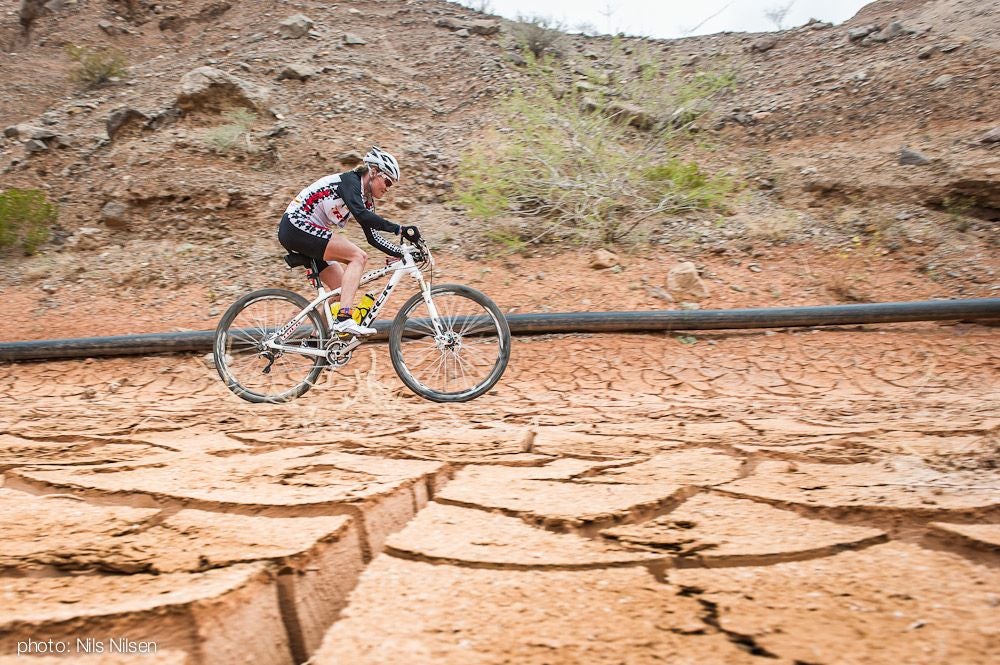How Do I Take My Long-Course Know-How Off-Road?

Melanie McQuaid at the 2012 XTERRA West Championship. (Photo: Nils Nilsen/Triathlete)
Ready to dive into the world of off-road triathlon? World champion Melanie McQuaid is here to help you translate your road skills to the dirt.
Long-course racing requires long, steady efforts, so training often emphasizes strength and endurance. Off-road tri requires more anaerobic efforts to make it up short, steep climbs on the bike and run, for example. So the best “bang for your buck” training for long-course athletes making the switch to dirt is lactate tolerance training. This will improve your ability to clear lactate, a substance your body produces during intense exercise that causes muscle fatigue. Tempo workouts and intervals will help you build the ability to recover from short bursts of speed or power while still maintaining a strong pace. This type of anaerobic work is best done with a strong base of endurance, which long-course athletes will already have. Add some lactate tolerance work with a few key workouts, and you’ll see improvements in your off-road endurance in as little as six to nine weeks.
Swim
The swim in off-road triathlon is split into two laps with a beach run in between, and a first turn buoy often less than 300 meters away. Sprinting to that turn can help keep you out of the fray or make a fast pack.
Speedwork will train your ability to start fast, settle in and have the speed to catch up to feet or manage the effort of a swim exit. Do this quick-start workout after your race-day warm-up to get those fast-twitch muscles firing.
5×100 with about 20 seconds rest (athletes swimming 1:20 should go on 1:40)
100 easy on 5 minutes rest
Repeat 1–3 times depending on fitness
Swim the first 100-meter repeat above a sustainable threshold pace. After the first repeat, the objective is to hold the fastest possible average for the remaining 100s. After the first set, the easy 100 meters represents a complete rest before starting into the next round.
Bike
Long-course athletes with weak bike-handling skills should focus on technical race-pace sessions instead of easy, low-speed work. Also, over-gear work off-road develops strength and trains good pedaling technique—you’ll notice any pedaling inefficiencies immediately when you lose power or traction. Changing up your cadence when you’re already in a big gear builds power and an ability to react to terrain and other racers with short bursts of speed. Finally, combining bursts of power with steady force training builds lactate tolerance. The following sets give you tons of training benefits: speed development, power, pedaling technique and bike-handling skills.
Cadence Grinder:
Warm up 10–20 minutes
Using a 5–6-minute hill, starting at a moderately hard gear, continuously do:
15 seconds standing pedal hard sprint without shifting
15 seconds sitting pedal without shifting
Immediately descend the climb at race intensity, recover fully and do 2–3 sets. As fatigue sets in, you might need to downshift, but the objective is to try to maintain even power throughout the interval.
Run
Lactate tolerance is important for the run in off-road triathlon, but more fast running is not always the way to build it. Let swimming and cycling lactate-tolerance work train your body to go harder longer. Then work on your running technique to use that fitness in the run .
Short ground contact time is the main goal. Developing short ground contact time minimizes disruption in running stride from obstacles, improves stability, speeds up leg turnover and creates injury resistance. Plyometric exercises train quick reaction time, preparing the body to run faster and be more agile on broken ground. This training builds strength and stability, and encourages proper foot placement and proprioception.
Plyometric training is intense, so consider it a quality run session and be conservative. One to two sessions per week, starting with jumps and hops in place is the safest way to avoid injury.
Jump rope: Start with skipping a rope with 20 double-leg hops and 2×10 single-leg hops. Build toward more single-leg skipping and sets of 30–60 seconds. Take complete rest between bouts of skipping.
Toe Taps: These help decrease ground contact time. This exercise creates good proprioception for foot placement and works on turnover speed by making you pick up your feet quickly. Stand in front of a bench and, one leg at a time, tap alternate toes quickly to the bench for 10 repetitions and rest. Start with 3×10 repetitions and build toward 30-second sets. Take complete rest before beginning another set.
Melanie McQuaid is a former pro world cup mountain bike racer, a four-time off-road triathlon world champion and six-time 70.3 champion. McQuaid is also certified by the Coaching Association of Canada and has been working with athletes for more than a decade through MelRad Coaching.